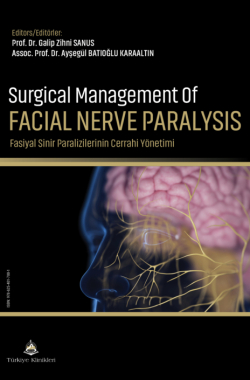Management of Ocular Problems After Facial Nerve Palsy
Ceyhun ARICIa, Burak MERGENb
aİstanbul University-Cerrahpaşa, Cerrahpaşa Faculty of Medicine, Department of Ophthalmology, İstanbul, Türkiye
bHealth Sciences University Başakşehir Çam and Sakura City Hospital, Clinic of Ophthalmology, İstanbul, Türkiye
Arıcı C, Mergen B. Management of ocular problems after facial nerve palsy. In: Sanus GZ, Batıoğlu Karaaltın A, eds. Surgical Management of Facial Nerve Paralysis. 1st ed. Ankara: Türkiye Klinikleri; 2022. p.244-9.
ABSTRACT
Facial nerve palsy (FNP) is the disturbance of the 7th cranial nerve (facial nerve) secondary to central or peripheral incidents. It can develop due to various etiologies and after the exclusion of all possible etiologies, Bell’s palsy is diagnosed. The most important complication of FNP is its ocular complications. It causes lagophthalmos leading to the disturbance of the eyelid blink dynamics and if left untreated, it may result in exposure keratopathy that may also lead to severe sight-threatening complications such as spontaneous corneal perforation. Although topical lubricants and medical treatment strategies might be sufficient in its early phase or mild forms, surgical options such as persistent or temporary tarsorrhaphy, upper eyelid loading, lower eyelid tightening procedures, etc. may also be preferred for the severe, chronic, or persistent cases. However, revealing and treating the underlying etiology is as important as the management of ocular complications. Furthermore, for the management of ocular complications due to FNP, coordination among ophthalmologists, otorhinolaryngologists, plastic and reconstructive surgeons, and patients is very important.
Keywords: Corneal ulcer; ectropion; eye; facial paralysis; keratitis
Kaynak Göster
Referanslar
- Katusic SK, Beard CM, Wiederholt WC, Bergstralh EJ, Kurland lT. Incidence, clinical features, and prognosis in Bell's palsy, Rochester, Minnesota, 1968-1982. Ann Neurol. 1986;20(5):622-7. [Crossref] [PubMed]
- Sibony PA, Evinger C, Manning KA. Eyelid movements in facial paralysis. Arch Ophthalmol. 1991;109(11):1555-61. [Crossref] [PubMed]
- Chi JJ. Management of the eye in facial paralysis. Facial Plast Surg Clin North Am. 2016;24(1):21-8. [Crossref] [PubMed]
- Başar E, Arıcı C. Use of botulinum neurotoxin in ophthalmology. Turk J Ophthalmol. 2016;46(6):282-90. [Crossref] [PubMed] [PMC]
- Demirci H, Frueh BR. Palpebral spring in the management of lagophthalmos and exposure keratopathy secondary to facial nerve palsy. Ophthalmic Plast Reconstr Surg. 2009;25(4):270-5. [Crossref] [PubMed]
- yu y, Sun J, Chen l, liu l. lid loading for treatment of paralytic lagophthalmos. Aesthetic Plast Surg. 2011;35(6):1165-71. [Crossref] [PubMed]
- Jobe RP. A technique for lid loading in the management of the lagophthalmos of facial palsy. Plast Reconstr Surg. 1974;53(1):29-32. [Crossref] [PubMed]
- Bergeron CM, Moe KS. The evaluation and treatment of upper eyelid paralysis. Facial Plast Surg. 2008;24(2):220-30. [Crossref] [PubMed]
- Berghaus A, Neumann K, Schrom T. The platinum chain: a new upperlid implant for facial palsy. Arch Facial Plast Surg. 2003;5(2):166-70. [Crossref] [PubMed]
- Silver Al, lindsay RW, Cheney Ml, Hadlock TA. Thin-profile platinum eyelid weighting: a superior option in the paralyzed eye. Plast Reconstr Surg. 2009;123(6):1697-703. [Crossref] [PubMed]
- Hassan AS, Frueh BR, Elner vM. Müllerectomy for upper eyelid retraction and lagophthalmos due to facial nerve palsy. Arch Ophthalmol. 2005;123(9):1221-5. [Crossref] [PubMed]
- Demirci H, Hassan AS, Reck SD, Frueh BR, Elner vM. Graded full-thickness anterior blepharotomy for correction of upper eyelid retraction not associated with thyroid eye disease. Ophthalmic Plast Reconstr Surg. 2007;23(1):39-45. [Crossref] [PubMed]
- Joseph SS, Joseph AW, Douglas RS, Massry GG. Periocular reconstruction in patients with facial paralysis. Otolaryngol Clin North Am. 2016;49(2):475-87. [Crossref] [PubMed]
- Taban M, Nakra T, Hwang C, Hoenig JA, Douglas RS, Shorr N, et al. Aesthetic lateral canthoplasty. Ophthalmic Plast Reconstr Surg. 2010;26(3):190-4. [Crossref] [PubMed]
- Moe KS, Kao CH. Precaruncular medial canthopexy. Arch Facial Plast Surg. 2005;7(4):244-50. [Crossref] [PubMed]
- Goldberg RA, Mancini R, Demer Jl. The transcaruncular approach: surgical anatomy and technique. Arch Facial Plast Surg. 2007;9(6):443-7. [Crossref] [PubMed]
- Sullivan SA, Dailey RA. Graft contraction: a comparison of acellular dermis versus hard palate mucosa in lower eyelid surgery. Ophthalmic Plast Reconstr Surg. 2003;19(1):14-24. [Crossref] [PubMed]
- Li TG, Shorr N, Goldberg RA. Comparison of the efficacy of hard palate grafts with acellular human dermis grafts in lower eyelid surgery. Plast Reconstr Surg. 2005;116(3):873-8; discussion 879-80. [Crossref] [PubMed]

